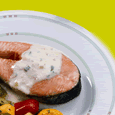Making modern aquaculture customer-led and not production-driven is the key objective for a global aquaculture conference, AquaVision 2004, in Stavanger, Norway.
Opening the conference, Hans den Bieman, the Chief Operating Officer of Nutreco Aquaculture, said, “modern aquaculture, with its production of fish such as salmon, trout and now cod, can contribute significantly to feeding the world with excellent protein but we must control its development responsibly to ensure sustainability, quality and safety. The industry must meet the demands of society while supplying what retail and food service customers need and what the consumers want.”
AquaVision 2004 has attracted over 350 delegates from five continents. They represent all interests in modern aquaculture, including key decision makers from feed and fish producers, retailers and food service as well as consumer representatives, top politicians and civil servants, the media, scientists and NGOs.
Keynote addresses came from two visionary professionals — a food business expert and an aquaculture expert with thought-provoking views on how to bring about the blue revolution and make aquaculture a thriving and sustainable source of aquatic protein.
Understand your markets
“Looking at aquaculture, it is clear that too often farms are occupied solely with producing; then the company does what it can to sell those products. This is an old business model and it does not suit today’s markets,” said Ray Cesca, President of Illinois-based consultancy GAEA International. Ray Cesca was previously the Managing Director for World Trade at McDonald’s Corporation.
“To build a durable business producing fish for consumers, the aquaculture industry must first learn to understand its markets. This means finding out what is happening in the food industry. What changes are taking place in food service? Are quick-service restaurants increasing? Is the consumption of food out of home increasing and if so, where do people get their meals? What is happening in the retail stores? Are consumers looking for more value-added processing to save them time in the kitchen? What factors are influencing food choices and diets? What effect do these changes have on the purchasing, preparation and consumption of fish?”
Community roots
In the second keynote address delegates were told, “We are in a period of rapid expansion for aquaculture, driven by population growth, the developing economies of Asian countries and increasing awareness of the health value of fish in the diet. However, to succeed, aquaculture must tie in with social structures and the natural ecology.” The message came form Barry Costa-Pierce, Professor of Fisheries and Aquaculture at the University of Rhode Island in the United States, director of Rhode Island Sea Grant and author of “Ecological Aquaculture: The Evolution of the Blue Revolution”.
The keynote addresses are followed by four sessions of presentations and debates to tackle key challenges on the road to sustainability.
AquaVision 2004
AquaVision 2004 is from 22 to 24 June in Stavanger, Norway and is the fifth in this successful series, which began in 1996. Each conference has drawn 300–400 delegates representing all interests in modern aquaculture, including feed manufacturers, fish producers, retailers, consumers, politicians and regulators, scientists and NGOs.
AquaVision 2004 incorporates the FAO Eastfish Salmon Summit, as in 2002. AquaVision is organised by Nutreco Aquaculture in co-operation with EUROFISH, which has developed from the FAO EASTFISH project (United Nations Food and Agriculture Organization); BASF Animal Health; Schering-Plough Animal Health; Fish Farming International, and Seafood. AquaVision also benefits from active participation by Rabobank.














